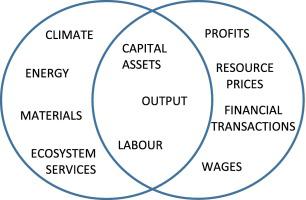Ecological Economics ( IF 6.6 ) Pub Date : 2021-11-08 , DOI: 10.1016/j.ecolecon.2021.107272 Christopher Kennedy 1

|
The circular flow diagram, whether in its limited form in macroeconomics, or broader form in ecological economics, depicts a duality of flows – physical resources in one direction with financial transactions in the opposite. Biophysical models of the economy can be constructed based on the physical flows and their associated stocks. In previous work, I demonstrated how the accumulation of wealth – measured by the capital stock – can be established using a biophysical model. With capital, energy use, and the distribution of labour determined by biophysical economics, here I investigate the range of potential distributions of wealth – profits versus wages – that follow in the political economy. The analysis is conducted using a four-sector model of Great Britain's economy from 1760 to 1913, including agriculture, coal mining, construction & materials, and production of goods and services. Energy price is a key variable in the model, influencing the distribution of income between different sectors. Taking the price of coal at historically observed values, the distribution of total factor income per worker is plotted as a trade-off between annual wages and profits per worker for example years of 1761, 1817, and 1871. The plots reveal how possible alternative distributions of income might be achieved under different political-economic regimes, subject to the same biophysical constraints. Conclusions are framed in the context of the grand challenges faced by ecological economists of developing environmentally sustainable economies with a just and equitable sharing of resources.
中文翻译:

生物物理经济学与政治经济学的交集
循环流程图,无论是宏观经济学中的有限形式,还是生态经济学中的更广泛形式,都描绘了流动的二元性——一个方向的物质资源与相反的金融交易。可以根据实物流量及其相关存量构建经济的生物物理模型。在之前的工作中,我展示了如何使用生物物理模型来建立财富的积累(以资本存量衡量)。通过生物物理经济学决定的资本、能源使用和劳动力分配,我在这里研究了政治经济学中的潜在财富分配范围——利润与工资。该分析是使用 1760 年至 1913 年英国经济的四部门模型进行的,包括农业、煤炭开采、建筑和 材料,以及商品和服务的生产。能源价格是模型中的一个关键变量,影响不同部门之间的收入分配。以历史观察值的煤炭价格为例,每个工人的全要素收入分布被绘制为每个工人的年工资和利润之间的权衡,例如 1761、1817 和 1871 年。这些图揭示了可能的替代分布的收入可能在不同的政治经济体制下实现,但受到相同的生物物理限制。结论是在生态经济学家所面临的巨大挑战的背景下制定的,这些挑战通过公正和公平的资源共享来发展环境可持续经济。影响不同部门之间的收入分配。以历史观察值的煤炭价格为例,每个工人的全要素收入分布被绘制为每个工人的年工资和利润之间的权衡,例如 1761、1817 和 1871 年。这些图揭示了可能的替代分布的收入可能在不同的政治经济体制下实现,但受到相同的生物物理限制。结论是在生态经济学家所面临的巨大挑战的背景下制定的,这些挑战通过公正和公平的资源共享来发展环境可持续经济。影响不同部门之间的收入分配。以历史观察值的煤炭价格为例,每个工人的全要素收入分布被绘制为每个工人的年工资和利润之间的权衡,例如 1761、1817 和 1871 年。这些图揭示了可能的替代分布的收入可能在不同的政治经济体制下实现,但受到相同的生物物理限制。结论是在生态经济学家所面临的巨大挑战的背景下制定的,这些挑战通过公正和公平的资源共享来发展环境可持续经济。每个工人的全要素收入分配被绘制为每个工人的年工资和利润之间的权衡,例如 1761、1817 和 1871 年。这些图揭示了在不同的政治经济条件下如何可能实现收入的替代分配制度,受到相同的生物物理限制。结论是在生态经济学家所面临的巨大挑战的背景下制定的,这些挑战通过公正和公平的资源共享来发展环境可持续经济。每个工人的全要素收入分配被绘制为每个工人的年工资和利润之间的权衡,例如 1761、1817 和 1871 年。这些图揭示了在不同的政治经济条件下如何可能实现收入的替代分配制度,受到相同的生物物理限制。结论是在生态经济学家所面临的巨大挑战的背景下制定的,这些挑战通过公正和公平的资源共享来发展环境可持续经济。











































 京公网安备 11010802027423号
京公网安备 11010802027423号